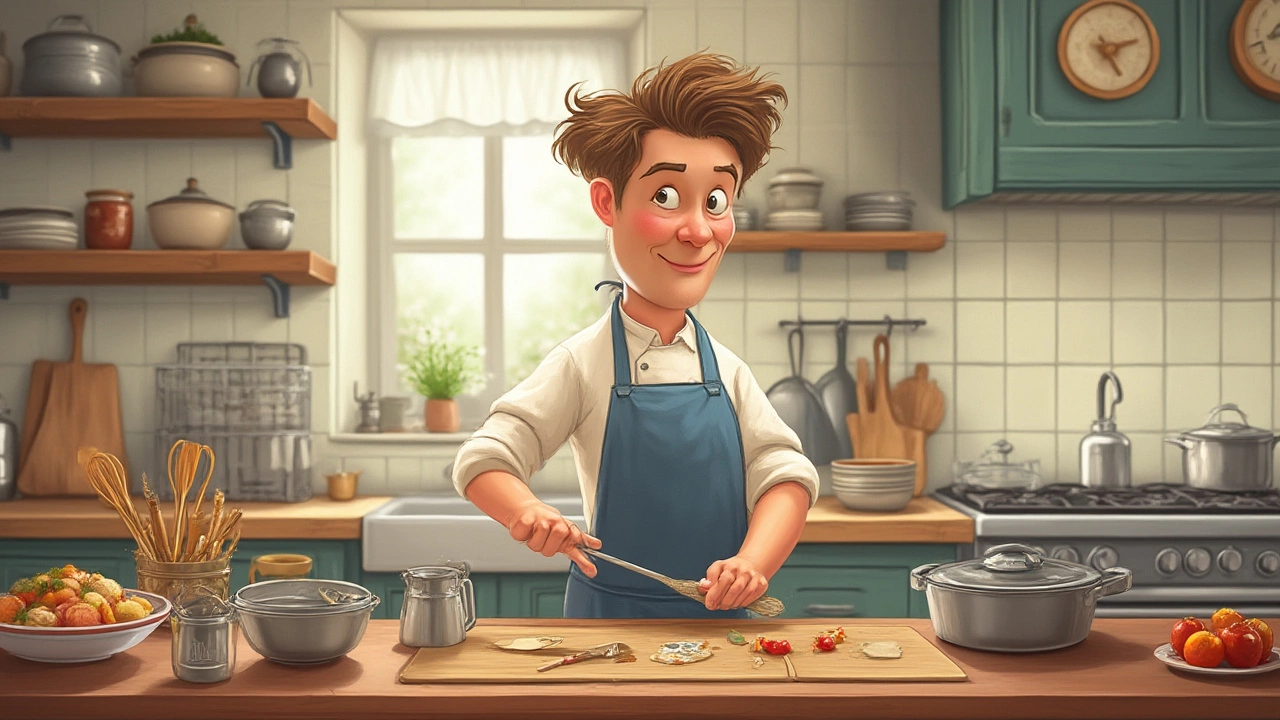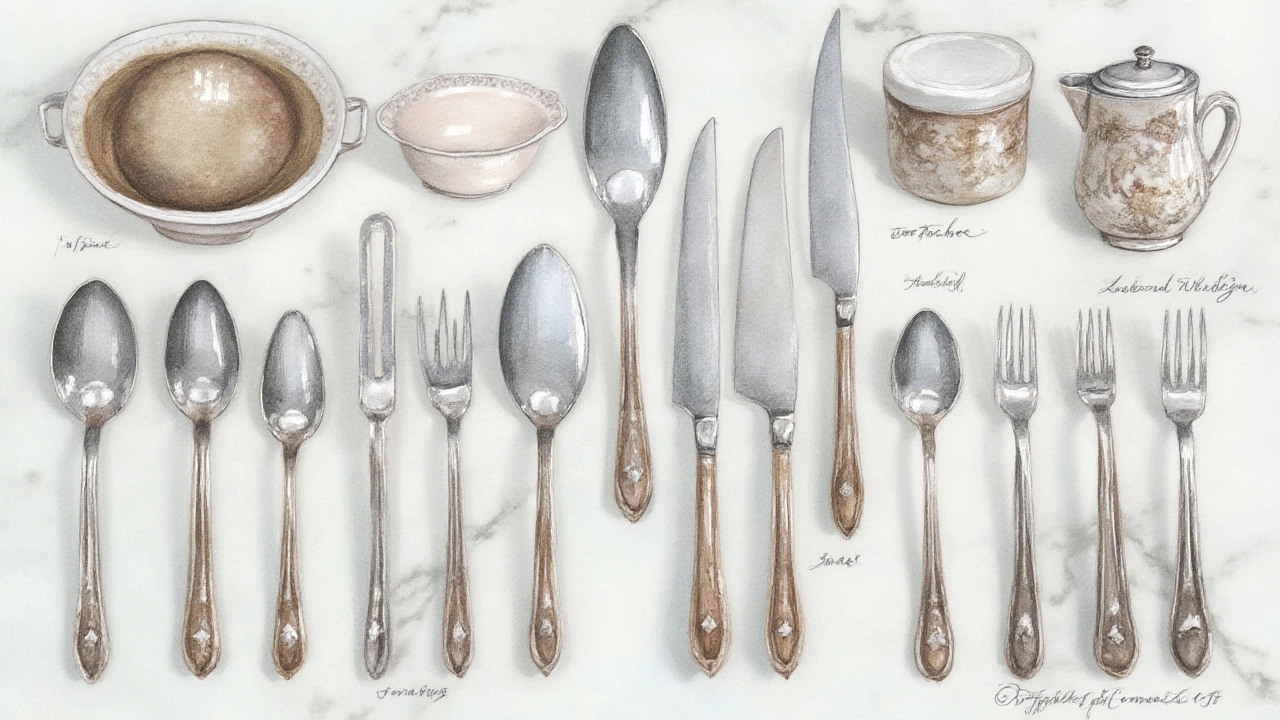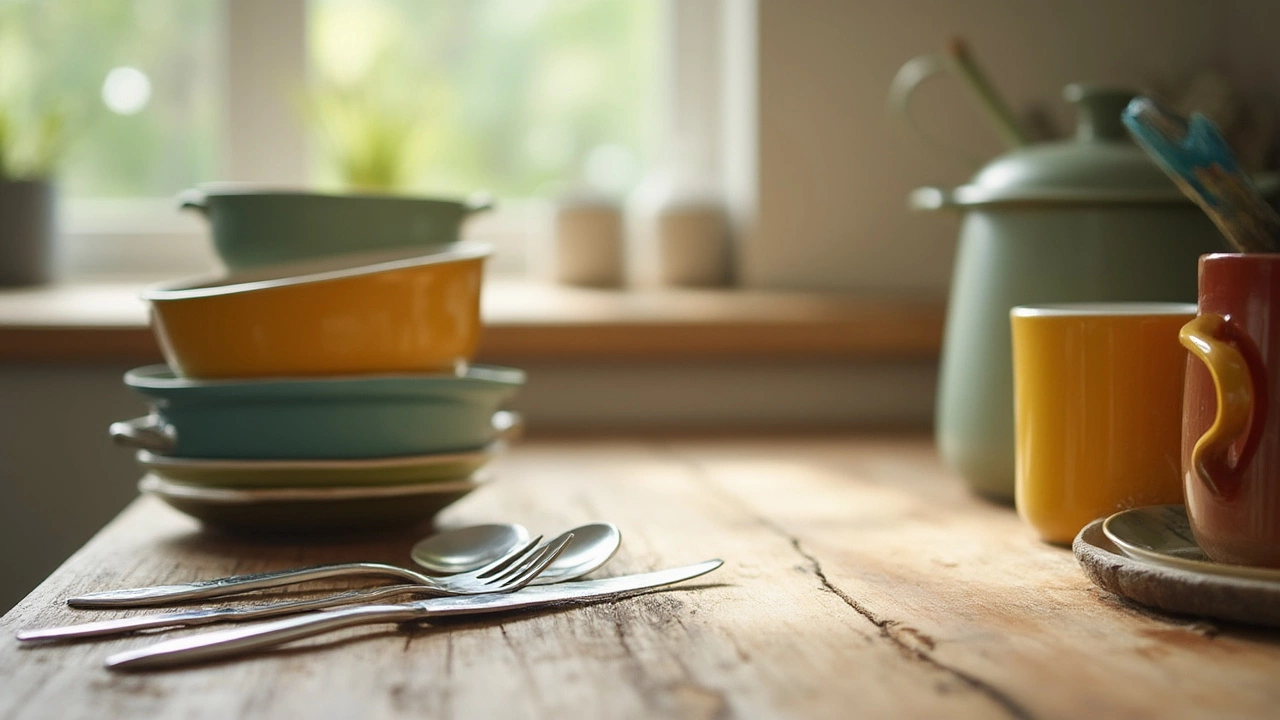Ever tried asking for a spatula at a friend's house and been handed something completely different—like a serving spoon or a ladle? Or maybe you’ve seen a fancy ad for ‘premium kitchenware’ and wondered if you already own half of it, hiding in your bottom drawer. The kitchen is one of those places where words and labels blur together until you find yourself sorting a stew ladle into a drawer labeled 'utensils' and shoving your poor baking pan in beside a potato masher. The lines get fuzzy. But if you want your kitchen to function like a well-oiled (or at least non-stick) machine, knowing the real difference between utensils and kitchenware can save time, money, and sanity. Let’s map it all out, one fork and frypan at a time.
Defining Utensils: More Than Just Spoons and Forks
Ask 10 people what a utensil is, and you’ll get 10 different answers—some even a little heated. At its most basic, a kitchen utensil is a handheld tool made for everyday prepping, mixing, and eating. The word itself goes way back to Latin, ‘utensilia,’ meaning ‘things for use,’ which is about as broad as it sounds. In practical terms, utensils are your bread-and-butter tools: spoons, forks, knives, peelers, spatulas, whisks, tongs, ladles, and all those oddball gadgets people gift at weddings. They’re the grab-and-go helpers you use every single day, often without even noticing. Imagine standing at a counter, bread in one hand, knife in the other—chances are, you’re clutching two utensils already.
But here’s the twist: not every item you use with your hands in the kitchen is technically a utensil. Would you call a mixing bowl a utensil? Probably not—it’s big, sits on the bench, and isn’t something you'd whisk eggs with, but rather whisk eggs in. That’s where this gets confusing. What makes a utensil special isn’t just being used in the kitchen, but being designed to interact directly with food while you prepare or eat it. Think of a classic wooden spoon stirring soup—direct contact, single hand, specific job. Chopsticks? Utensils. Salad spinner? Still not a utensil, despite your hope that it would do the dinner for you.
People love to debate about edge cases (is a garlic press a utensil?), but experts—like the editors at Good Housekeeping—pin it down to “tools held in the hand and used for food preparation, cooking, or eating.” No batteries. No electrical cords. Here’s a quick checklist for spotting utensils:
- Small, portable, used by hand
- Usually one or two-handed operation
- Directly interact with food (prep, serve, eat)
- Usually non-mechanical, no built-in motors
This slice of the kitchen world matters because it keeps things easy: if you can toss it in the dishwasher silverware tray, it’s almost certainly a utensil.
What Counts as Kitchenware: Looking at the Bigger Picture
So, what exactly is kitchenware? Here’s where things open up wide. Kitchenware is the grandparent umbrella that shelters everything you use while prepping, cooking, serving, and sometimes even storing food. It includes utensils for sure, but also pots, pans, mixing bowls, baking dishes, measuring cups, and anything that’s more ‘gear’ than ‘tool’. The line stretches far: roasting pans, cutting boards, colanders, casserole dishes, graters, pie plates—you get the idea.
Kitchenware is all about function and category. Is it something you use in the kitchen, or does it help with food or drink in any way? Congratulations, it’s kitchenware. Even things like rolling pins, canisters, pressure cookers, and glass storage containers fall into this club. It doesn’t have to touch the food directly either. Take oven mitts. They’re not coming into contact with your lasagna, but they certainly help with the making and transport of it. Kitchenware often means the equipment—the containers, cookware, bakeware, tools, and storage—in your kitchen, and yes, sometimes the gadgets too.
There’s no single official global standard—retailers love to switch up the definition. But usually, kitchenware is broken into categories:
- Cookware: Pots, pans, skillets, woks
- Bakeware: Cake tins, muffin trays, cookie sheets
- Serveware: Platters, serving bowls, pitchers
- Storage: Jars, boxes, canisters, lunchboxes
- Cutlery and utensils: Spoons, forks, chopping knives, tongs
- Miscellaneous gadgets
This helps you track down what’s missing from your cupboard, or explains why your ‘kitchenware drawer’ is so impossible to shut. Kitchenware is a kitchen’s backbone—without it, you’re basically camping every night.

Key Differences: Why It Actually Matters
The short answer to all this? Utensils are a subset of kitchenware. But why does that distinction matter in daily life? The most obvious reason: storage, shopping, and cleaning. A utensil drawer makes sense because you want all your knives, forks, spoons, tongs, and whisks easy to grab—not lost among baking pans. When you’re shopping, knowing whether you need a new utensil set or if your kitchenware is missing something larger (hello, roasting pan) saves embarrassing double-ups. Ever bought three spatulas thinking you’d lost yours, only to find the original slid behind a pile of mixing bowls? Guilty as charged.
The difference also comes up when you’re reading recipes or packing up for a picnic. A recipe might instruct, “using a kitchen utensil, mix the batter,”—they absolutely don’t mean your frying pan. Or, if you’re moving and the agency asks you to list kitchenware included in the apartment, they expect plates and pots, not just a few salad tongs.
Here’s a quick at-a-glance table to compare the two:
| Kitchen Utensils | Kitchenware |
|---|---|
| Handheld tools | All tools and equipment for cooking, serving, & storing food |
| Used directly to prepare/eat food | Includes utensils plus bakeware, cookware, serveware, storage |
| Usually no electrical parts | May include mechanical/manual gadgets |
| Examples: spatula, whisk, peeler | Examples: roasting tin, mixing bowl, casserole dish, spatula |
People often forget that while all utensils are kitchenware, not all kitchenware are utensils. That’s why you can get kitchenware sets that include a soup pot, but no soup ladle—the set covers gear, not necessarily the small tools. If you’re giving gifts, outfitting a new flat, or just want to tidy up the kitchen, knowing the difference makes a real difference.
Common Examples of Each: What Belongs Where?
Sorting through the mess of gear in a modern kitchen can feel like a treasure hunt or sometimes like digging through a landfill. So let's break out concrete examples—picture your own kitchen as you read through.
- Utensils: soup ladle, spatula, potato masher, apple corer, garlic press, serving spoon, ice cream scoop, peeler, fork, knife, chopsticks, whisk, slotted spoon, tongs. These are mostly lined up in a drawer or a jug on the countertop, ready to act.
- Kitchenware includes all your utensils plus: pots, frying pans, baking sheets, rolling pins, mixing bowls, graters, salad spinners, food storage containers, casserole dishes, roasting pans, colanders, measuring jugs, bread bins, oven trays, grill racks, and the list goes on.
A cutting board? Kitchenware, not a utensil. Measuring spoons? Both—a type of utensil but sold as kitchenware. Fancy espresso machine? Kitchenware, unless you use the steam spout as a whisk, which I don’t recommend (unless you're keen on cleaning up foam disasters). This distinction also plays out in shops. Go to a big-box store or scroll through an online shop, and you’ll run across sections that help you navigate by these terms. If you're furnishing a kitchen all at once, check the bundles—many ‘kitchenware sets’ will leave out actual utensils, which you then need to buy separately.
There’s a practical reason for these categories, too. In New Zealand (and lots of other places), stores price utensils separately because they’re easy to lose or wear out. Pots last for ages, but can you say the same for your dollar-store peeler? Not a chance. Utensils see the most action, so they rotate faster in and out of the kitchen. That’s why friends who bake or cook a lot, like me (and occasionally Caleb, when he’s on dinner duty), swear by buying sturdier tools and keeping them in the easiest spot to reach.
“The best kitchen is one where everything has its place, every tool does its job, and you never end up stirring soup with a butter knife,” — Chef Samin Nosrat, Salt, Fat, Acid, Heat.
Relatable, right? The table below shows what typical Kiwi homes keep as must-have utensils and essential kitchenware pieces for daily life in Wellington:
| Utensils | Kitchenware |
|---|---|
| Chef’s knife | Stock pot |
| Whisk | Baking tray |
| Tongs | Mixing bowl |
| Vegetable peeler | Pyrex dish |
| Pasta fork | Colander |
| Ice cream scoop | Storage jar |

Tips for Choosing and Organizing Your Kitchen Tools
If your kitchen feels more like a puzzle than a workspace, you’re not alone. The trick lies in understanding your habits and sorting accordingly. Start with what you grab most, whether it’s a wooden spoon, a paring knife, or a slotted spatula. These belong in their own utensil drawer or hanging on a rack for easy access. No more wrestling with a jumbled mess during the 5:30 dinner rush.
Group your kitchenware by function: put all your bakeware in the same cupboard or pull-out, stack pots and pans with their lids nearby, and keep bowls nested. For those with limited space (tiny Wellington flats, anyone?), try vertical storage for things like chopping boards and use drawer dividers for utensils. Want to save yourself dozens of kitchen headaches? Invest in a few quality utensils—a chef’s knife, sturdy spatula, and solid whisk beat a huge drawer of cheap alternatives any day.
It’s also worth making a home inventory if you move around a lot, so you don’t double-buy or leave behind a favorite pan. And don’t fall for every gadget advertised as revolutionary—unless it solves a real daily problem, it’ll become kitchen clutter.
- Check what your recipes call for. If your favorite dinner needs a zester or a garlic press, get a sturdy one—not the cheapest available.
- Choose utensils made from materials that suit your cookware. Metal spatulas scratch nonstick pans; silicone or wooden is better there.
- Replace anything that’s damaged, melted, or wobbly. Broken tools are a hazard (trust me, I’ve nicked a finger more than once on an old peeler).
- Store daily-use utensils where you can see and grab them fast. Move rarely-used items higher up or into a separate drawer/cabinet.
If you share a kitchen (with flatmates or a spouse like Caleb), make clean-up easier by labeling drawers or using little bins inside for utensils, so nobody can say “I couldn’t find the whisk!” ever again. And if you love data, here’s a fun stat: a recent Study by the Food Service Technology Center found professional kitchens can lose up to 20% of small utensils per year, mostly to the trash by mistake. Maybe grab that stray fork before it dives into the recycling!
The takeaway? Know the difference, buy for your needs, and keep things organized so dinner goes from chaos to calm—maybe even a little bit fun.







